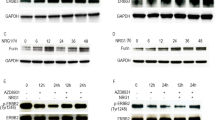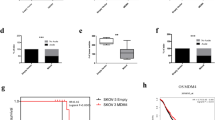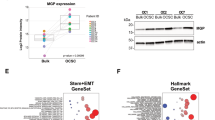Abstract
Tissue transglutaminase (TG2), an enzyme involved in cell proliferation, differentiation and apoptosis is overexpressed in ovarian carcinomas, where it modulates epithelial-to-mesenchymal transition (EMT) and promotes metastasis. Its regulation in ovarian cancer (OC) remains unexplored. Here, we show that transforming growth factor (TGF)-β, a cytokine involved in tumor dissemination is abundantly secreted in the OC microenvironment and induces TG2 expression and enzymatic activity. This is mediated at transcriptional level by SMADs and by TGF-β-activated kinase 1-mediated activation of the nuclear factor-κB complex. TGF-β-stimulated OC cells aggregate as spheroids, which enable peritoneal dissemination. We show that TGF-β-induced TG2 regulates EMT, formation of spheroids and OC metastasis. TG2 knock-down in OC cells decreases the number of cells harboring a cancer stem cell phenotype (CD44+/CD117+). Furthermore, CD44+/CD117+ cells isolated from human ovarian tumors express high levels of TG2. In summary, TGF-β-induced TG2 enhances ovarian tumor metastasis by inducing EMT and a cancer stem cell phenotype.
This is a preview of subscription content, access via your institution
Access options
Subscribe to this journal
Receive 50 print issues and online access
$259.00 per year
only $5.18 per issue
Buy this article
- Purchase on Springer Link
- Instant access to full article PDF
Prices may be subject to local taxes which are calculated during checkout








Similar content being viewed by others
References
Abendstein B, Stadlmann S, Knabbe C, Buck M, Muller-Holzner E, Zeimet AG et al. (2000). Regulation of transforming growth factor-beta secretion by human peritoneal mesothelial and ovarian carcinoma cells. Cytokine 12: 1115–1119.
Akhurst RJ, Derynck R . (2001). TGF-beta signaling in cancer--a double-edged sword. Trends Cell Biol 11: S44–S51.
Akimov SS, Belkin AM . (2001). Cell surface tissue transglutaminase is involved in adhesion and migration of monocytic cells on fibronectin. Blood 98: 1567–1576.
Al-Hajj M, Clarke MF . (2004). Self-renewal and solid tumor stem cells. Oncogene 23: 7274–7282.
Baldwin RL, Tran H, Karlan BY . (2003). Loss of c-myc repression coincides with ovarian cancer resistance to transforming growth factor beta growth arrest independent of transforming growth factor beta/Smad signaling. Cancer Res 63: 1413–1419.
Bartlett JM, Langdon SP, Scott WN, Love SB, Miller EP, Katsaros D et al. (1997). Transforming growth factor-beta isoform expression in human ovarian tumours. Eur J Cancer 33: 2397–2403.
Bristow RE, Baldwin RL, Yamada SD, Korc M, Karlan BY . (1999). Altered expression of transforming growth factor-beta ligands and receptors in primary and recurrent ovarian carcinoma. Cancer 85: 658–668.
Cao L, Petrusca DN, Satpathy M, Nakshatri H, Petrache I, Matei D . (2008). Tissue transglutaminase protects epithelial ovarian cancer cells from cisplatin-induced apoptosis by promoting cell survival signaling. Carcinogenesis 29: 1893–1900.
Cardillo MR, Yap E, Castagna G . (1997). Molecular genetic analysis of TGF-beta1 in ovarian neoplasia. J Exp Clin Cancer Res 16: 49–56.
Chen T, Triplett J, Dehner B, Hurst B, Colligan B, Pemberton J et al. (2001). Transforming growth factor-beta receptor type I gene is frequently mutated in ovarian carcinomas. Cancer Res 61: 4679–4682.
Chou CY, Streets AJ, Watson PF, Huang L, Verderio EA, Johnson TS . (2011). A crucial sequence for transglutaminase type 2 extracellular trafficking in renal tubular epithelial cells lies in its N-terminal {beta}-sandwich domain. J Biol Chem 286: 27825–27835.
Comijn J, Berx G, Vermassen P, Verschueren K, van Grunsven L, Bruyneel E et al. (2001). The two-handed E box binding zinc finger protein SIP1 downregulates E-cadherin and induces invasion. Mol Cell 7: 1267–1278.
Dennis PA, Rifkin DB . (1991). Cellular activation of latent transforming growth factor beta requires binding to the cation-independent mannose 6-phosphate/insulin-like growth factor type II receptor. Proc Natl Acad Sci USA 88: 580–584.
Derynck R, Zhang YE . (2003). Smad-dependent and Smad-independent pathways in TGF-beta family signalling. Nature 425: 577–584.
Dontu G, Abdallah WM, Foley JM, Jackson KW, Clarke MF, Kawamura MJ et al. (2003). In vitro propagation and transcriptional profiling of human mammary stem/progenitor cells. Genes Dev 17: 1253–1270.
Dowdy SC, Mariani A, Janknecht R . (2003). HER2/Neu- and TAK1-mediated up-regulation of the transforming growth factor beta inhibitor Smad7 via the ETS protein ER81. J Biol Chem 278: 44377–44384.
Dumont N, Bakin AV, Arteaga CL . (2003). Autocrine transforming growth factor-beta signaling mediates Smad-independent motility in human cancer cells. J Biol Chem 278: 3275–3285.
Gillan L, Matei D, Fishman DA, Gerbin CS, Karlan BY, Chang DD . (2002). Periostin secreted by epithelial ovarian carcinoma is a ligand for alpha(V)beta(3) and alpha(V)beta(5) integrins and promotes cell motility. Cancer Res 62: 5358–5364.
Hanafusa H, Ninomiya-Tsuji J, Masuyama N, Nishita M, Fujisawa J, Shibuya H et al. (1999). Involvement of the p38 mitogen-activated protein kinase pathway in transforming growth factor-beta-induced gene expression. J Biol Chem 274: 27161–27167.
Hang J, Zemskov EA, Lorand L, Belkin AM . (2005). Identification of a novel recognition sequence for fibronectin within the NH2-terminal beta-sandwich domain of tissue transglutaminase. J Biol Chem 280: 23675–23683.
Hocevar BA, Prunier C, Howe PH . (2005). Disabled-2 (Dab2) mediates transforming growth factor beta (TGFbeta)-stimulated fibronectin synthesis through TGFbeta-activated kinase 1 and activation of the JNK pathway. J Biol Chem 280: 25920–25927.
Hu W, Wu W, Nash MA, Freedman RS, Kavanagh JJ, Verschraegen CF . (2000). Anomalies of the TGF-beta postreceptor signaling pathway in ovarian cancer cell lines. Anticancer Res 20: 729–733.
Hurteau JA, Allison BM, Brutkiewicz SA, Goebl MG, Heilman DK, Bigsby RM et al. (2001). Expression and subcellular localization of the cyclin-dependent kinase inhibitor p27(Kip1) in epithelial ovarian cancer. Gynecol Oncol 83: 292–298.
Kopp A, Jonat W, Schmahl M, Knabbe C . (1995). Transforming growth factor beta 2 (TGF-beta 2) levels in plasma of patients with metastatic breast cancer treated with tamoxifen. Cancer Res 55: 4512–4515.
Lopez-Rovira T, Chalaux E, Rosa JL, Bartrons R, Ventura F . (2000). Interaction and functional cooperation of NF-kappa B with Smads. Transcriptional regulation of the junB promoter. J Biol Chem 275: 28937–28946.
Lynch MA, Nakashima R, Song H, DeGroff VL, Wang D, Enomoto T et al. (1998). Mutational analysis of the transforming growth factor beta receptor type II gene in human ovarian carcinoma. Cancer Res 58: 4227–4232.
Mani SA, Guo W, Liao MJ, Eaton EN, Ayyanan A, Zhou AY et al. (2008). The epithelial-mesenchymal transition generates cells with properties of stem cells. Cell 133: 704–715.
Mann AP, Verma A, Sethi G, Manavathi B, Wang H, Fok JY et al. (2006). Overexpression of tissue transglutaminase leads to constitutive activation of nuclear factor-{kappa}B in cancer cells: delineation of a novel pathway. Cancer Res 66: 8788–8795.
Massague J . (1996). TGFbeta signaling: receptors, transducers, and Mad proteins. Cell 85: 947–950.
Matei D, Graeber TG, Baldwin RL, Karlan BY, Rao J, Chang DD . (2002). Gene expression in epithelial ovarian carcinoma. Oncogene 21: 6289–6298.
Mehta K, Fok J, Miller FR, Koul D, Sahin AA . (2004). Prognostic significance of tissue transglutaminase in drug resistant and metastatic breast cancer. Clin Cancer Res 10: 8068–8076.
Mohammad KS, Javelaud D, Fournier PG, Niewolna M, McKenna CR, Peng XH et al. (2011). TGF-beta-RI kinase inhibitor SD-208 reduces the development and progression of melanoma bone metastases. Cancer Res 71: 175–184.
Moreno-Bueno G, Cubillo E, Sarrio D, Peinado H, Rodriguez-Pinilla SM, Villa S et al. (2006). Genetic profiling of epithelial cells expressing E-cadherin repressors reveals a distinct role for Snail, Slug, and E47 factors in epithelial-mesenchymal transition. Cancer Res 66: 9543–9556.
Nagafuchi A, Shirayoshi Y, Okazaki K, Yasuda K, Takeichi M . (1987). Transformation of cell adhesion properties by exogenously introduced E-cadherin cDNA. Nature 329: 341–343.
Nilsson E, Doraiswamy V, Parrott JA, Skinner MK . (2001). Expression and action of transforming growth factor beta (TGFbeta1, TGFbeta2, TGFbeta3) in normal bovine ovarian surface epithelium and implications for human ovarian cancer. Mol Cell Endocrinol 182: 145–155.
Perl AK, Wilgenbus P, Dahl U, Semb H, Christofori G . (1998). A causal role for E-cadherin in the transition from adenoma to carcinoma. Nature 392: 190–193.
Pincus JH, Waelsch H . (1968). The specificity of transglutaminase. II. Structural requirements of the amine substrate. Arch Biochem Biophys 126: 44–52.
Qiao B, Padilla SR, Benya PD . (2005). Transforming growth factor (TGF)-beta-activated kinase 1 mimics and mediates TGF-beta-induced stimulation of type II collagen synthesis in chondrocytes independent of Col2a1 transcription and Smad3 signaling. J Biol Chem 280: 17562–17571.
Rodriguez GC, Haisley C, Hurteau J, Moser TL, Whitaker R, Bast Jr RC et al. (2001). Regulation of invasion of epithelial ovarian cancer by transforming growth factor-beta. Gynecol Oncol 80: 245–253.
Satpathy M, Cao L, Pincheira R, Emerson R, Bigsby R, Nakshatri H et al. (2007). Enhanced peritoneal ovarian tumor dissemination by tissue transglutaminase. Cancer Res 67: 7194–7202.
Satpathy M, Shao M, Emerson R, Donner DB, Matei D . (2009). Tissue transglutaminase regulates matrix metalloproteinase-2 in ovarian cancer by modulating cAMP-response element-binding protein activity. J Biol Chem 284: 15390–15399.
Shao M, Cao L, Shen C, Satpathy M, Chelladurai B, Bigsby RM et al. (2009). Epithelial-to-mesenchymal transition and ovarian tumor progression induced by tissue transglutaminase. Cancer Res 69: 9192–9201.
Sodek KL, Ringuette MJ, Brown TJ . (2009). Compact spheroid formation by ovarian cancer cells is associated with contractile behavior and an invasive phenotype. Int J Cancer 124: 2060–2070.
Szotek PP, Pieretti-Vanmarcke R, Masiakos PT, Dinulescu DM, Connolly D, Foster R et al. (2006). Ovarian cancer side population defines cells with stem cell-like characteristics and Mullerian inhibiting substance responsiveness. Proc Natl Acad Sci USA 103: 11154–11159.
Thiery JP . (2002). Epithelial-mesenchymal transitions in tumour progression. Nat Rev Cancer 2: 442–454.
Thuault S, Valcourt U, Petersen M, Manfioletti G, Heldin CH, Moustakas A . (2006). Transforming growth factor-beta employs HMGA2 to elicit epithelial-mesenchymal transition. J Cell Biol 174: 175–183.
Tobin SW, Douville K, Benbow U, Brinckerhoff CE, Memoli VA, Arrick BA . (2002). Consequences of altered TGF-beta expression and responsiveness in breast cancer: evidence for autocrine and paracrine effects. Oncogene 21: 108–118.
Vincent T, Neve EP, Johnson JR, Kukalev A, Rojo F, Albanell J et al. (2009). A SNAIL1-SMAD3/4 transcriptional repressor complex promotes TGF-beta mediated epithelial-mesenchymal transition. Nat Cell Biol 11: 943–950.
Wakahara K, Kobayashi H, Yagyu T, Matsuzaki H, Kondo T, Kurita N et al. (2004). Transforming growth factor-beta1-dependent activation of Smad2/3 and up-regulation of PAI-1 expression is negatively regulated by Src in SKOV-3 human ovarian cancer cells. J Cell Biochem 93: 437–453.
Yamada SD, Baldwin RL, Karlan BY . (1999). Ovarian carcinoma cell cultures are resistant to TGF-beta1-mediated growth inhibition despite expression of functional receptors. Gynecol Oncol 75: 72–77.
Yamaguchi K, Shirakabe K, Shibuya H, Irie K, Oishi I, Ueno N et al. (1995). Identification of a member of the MAPKKK family as a potential mediator of TGF-beta signal transduction. Science 270: 2008–2011.
Yamashita S, Miyagi C, Fukada T, Kagara N, Che YS, Hirano T . (2004). Zinc transporter LIVI controls epithelial-mesenchymal transition in zebrafish gastrula organizer. Nature 429: 298–302.
Zawel L, Dai JL, Buckhaults P, Zhou S, Kinzler KW, Vogelstein B et al. (1998). Human Smad3 and Smad4 are sequence-specific transcription activators. Mol Cell 1: 611–617.
Zhang J, Lesort M, Guttmann RP, Johnson GV . (1998). Modulation of the in situ activity of tissue transglutaminase by calcium and GTP. J Biol Chem 273: 2288–2295.
Zhang S, Balch C, Chan MW, Lai HC, Matei D, Schilder JM et al. (2008). Identification and characterization of ovarian cancer-initiating cells from primary human tumors. Cancer Res 68: 4311–4320.
Acknowledgements
We thank Drs J Tucholski, H Nakshatri, Y Xu, A Belkin and R Bigsby for reagents and Dr A Belkin for useful discussion. This work was supported by the US Department of Veterans Affairs through a VA Merit Award and by the American Cancer Society through a Research Scholar grant to DM.
Author information
Authors and Affiliations
Corresponding author
Ethics declarations
Competing interests
The authors declare no conflict of interest.
Additional information
Supplementary Information accompanies the paper on the Oncogene website
Supplementary information
Rights and permissions
About this article
Cite this article
Cao, L., Shao, M., Schilder, J. et al. Tissue transglutaminase links TGF-β, epithelial to mesenchymal transition and a stem cell phenotype in ovarian cancer. Oncogene 31, 2521–2534 (2012). https://doi.org/10.1038/onc.2011.429
Received:
Revised:
Accepted:
Published:
Issue Date:
DOI: https://doi.org/10.1038/onc.2011.429
Keywords
This article is cited by
-
Canonical and truncated transglutaminase-2 regulate mucin-1 expression and androgen independency in prostate cancer cell lines
Cell Death & Disease (2023)
-
Transglutaminases are oncogenic biomarkers in human cancers and therapeutic targeting of TGM2 blocks chemoresistance and macrophage infiltration in pancreatic cancer
Cellular Oncology (2023)
-
RBM10 regulates alternative splicing of lncRNA Neat1 to inhibit the invasion and metastasis of NSCLC
Cancer Cell International (2022)
-
Maelstrom promotes tumor metastasis through regulation of FGFR4 and epithelial-mesenchymal transition in epithelial ovarian cancer
Journal of Ovarian Research (2022)
-
High-throughput sequencing identification of differentially expressed microRNAs in metastatic ovarian cancer with experimental validations
Cancer Cell International (2020)



